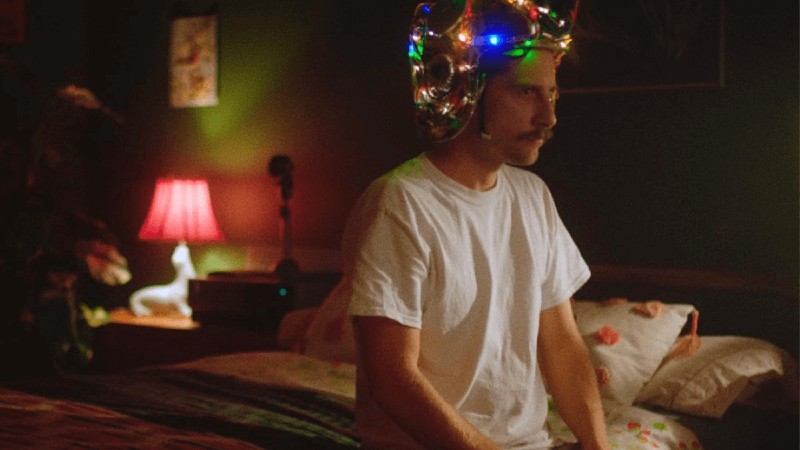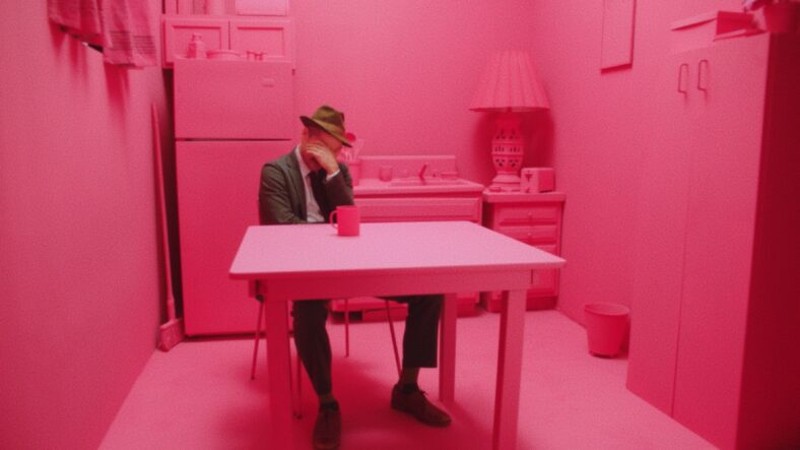




AmeThe two directors of the micro-budget sci-fi/fantasy Strawberry Mansion (2022) have created a film with shades of Terry Gilliam, Michel Gondry and Wes Anderson, centring on an auditor who in the future records and taxes dreams, and gets caught up in the dreams of an eccentric old lady.
A lot of the effects are as old as cinema – with plenty of in-camera effects, not much CGI, and a handmade feel. It has a visually rich and colourful palette that goes against the grain of the dark indie trend of the moment.
Here is Ian Schultz’s conversation with the two American filmmakers, Kentucker Audley and Albert Birney via videoconferencing. Kentucker is also the lead in the film.
…
.
Ian Schultz – I see a lot of similarities between Strawberry Mansion and Brazil (Terry Gilliam, 1985). What was your first exposure to Gilliam’s work, and what did you learn from watching his movies over the years?
Albert Biney – My first exposure was The Adventures of Baron Munchausen (1989). I was at my buddy’s house, it was a new release and he popped it on. It was just a wild ride – I must’ve been eight or nine years old. Couple of years later, you get a little older, my same friend showed me Monty Python, and you get his animations and you go, “whoa, he’s cool.” Then when you think you’ve seen what he’s got, you’re 15 and you are like, renting horror movies or sci-fi movies, and they have a trailer for Brazil before it. I think it was one of the first times my friends and I ever rewound the trailer before the movie even started. We just watched the trailer again—it was like, “OK we’ve got to rent this.” The next weekend we rent Brazil, and it was just a good five or six years of just Brazil, watching Brazil, talking Brazil.
Around this time the Criterion Collection DVD with the longer cut came out. Then you’re like, “let’s see what else he has got?” The Fisher King (Gilliam, 1991) – that was a good time, I remember watching that, starting to become aware that there was a person behind the film, you know, a director who had a vision, and this was their vision.
Certain movies are in your DNA, you watch them so much as a kid. I don’t think I’ve seen Brazil in 20-plus years at this point, but it’s still in there. When we were making this movie, it’s not like we went back and watched Brazil, but it was a formative experience, it’s part of us.
IS – How did you pull off the special effects? Your mixture of stop-motion animation and CGI looks amazing – I’d like to know more about the process, especially with the boat and the Blue Demon.
Kentucker Audley – It was a combination of things. It was definitely sort of bringing together a team, a network of friends and collaborators to help us flesh out this world. It was an experimental and exploratory process.
Albert had done a lot of very rudimentary stop-motion animation. We wanted to have that sort of small-scale, handmade feel to it so Albert did a lot of the on-set stop motion. From there we wanted to explore some more elaborate effects, so we just enlisted some friends. The primary stop-motion animator we were working with was from Portland, Oregon, his name is Lawrence Becker, who we’ve been going back and forth with over the years, just out of mutual respect and admiration. Just let him do his thing and see how it would fit into our vision.
AB – Even though we didn’t have the budget, there are X amount of VFX shots. How can we get Lawrence to do three or four of them, how do we get this friend who does computer animation to do something? There was always a way. We were just going to try to tell this big story in this small way we have, but make it feel as big as we can make it feel. And if it feels handmade and homemade, that’s OK too. All of these films we grew up watching, there were artists or animators or people doing things. Sometimes when you get the modern stuff, it’s so slick, and you just lose any sense of people behind the thing. We want to… even if they are doing computer graphics, it’s still one person doing computer visual art stuff. It can still feel like their voice is in it a bit.

IS – Which animators were the biggest influences on your work?
AB – Oh gosh, I personally love Don Hertzfeldt, an independent animator. Henry Selick and he have a new one coming out. I haven’t seen Phil Tippett’s Mad God (2022) yet, but I just watched the Industrial [TV series] Light and Magic behind-the- scenes,” and he is a big part of that, and it really got me excited to watch that. Anybody who takes 35 years to make a film – we’ve got to support that guy!
IS – What about Jan Svankmajer?
AB – He is kind of the big one. When I was 18, I had a film professor from Czechoslovakia. He showed Alice (1988), the Alice in Wonderland adaptation that Svankmajer did. It’s kind of “look at my life before that moment and after,” it definitely clicked something in my brain. This is some wild stuff, the surrealism here, the animation, the darkness, even the humour and the way he puts it all together. He is a big inspiration forever.
IS – What did you do with the production design that made your film so visually rich on a low budget?
KA – It’s kind of the same deal, just doing what we can ourselves. There were very few sets. The pink room was a built set in a studio. A lot of green screen stuff, but in terms of screen time there aren’t a lot of scenes or footage from the film that were shot on green screen. A lot of it was in the house, of course, a lot of it was existing within the house that we filmed in. A lot of it was just Albert and our production designer, Becca Morrin, just filling the frame with a bunch of old stuff, colourful antiques and exciting visual elements. A lot of it was just VHS composition, just trying to put as much VHS tapes on shelves and label them in fun ways and have them interact with the scenes. What else, Al?
AB – The colour, it’s not like we ever sat down and said we are going to make a colourful movie and dump a lot of colour in. It happens naturally: let’s make this room all pink, this room will be green, she is an artist so she is kind of wearing colourful outfits, so there is a lot of colour in her house. It’s one of those things when people say: “wow, how come you have all these colours in your film?” I’m like, “I don’t know.” I just think it’s fun to look at colours if you are shooting in colour. We knew we going to put it to film at the end, transfer it from digital to film. Thinking of that, what colours, certain colours will bleed a little bit, some reds. We were just making it very rich and textual, and the colour is just a part of that.
IS – One thing you did that I thought was pretty genius was shooting digitally, transferring to 16mm and then retransferring to digital. Where did the idea for that come from?
AB – I think it just goes back to the fact that both Kentucker and I just love movies—we grew up watching all the classics, and all of them were all shot on film. They all had the grain and beautiful things that film captures that digital just doesn’t quite get. We were inspired by those movies. This movie was wanting to make our version of those movies we loved watching as kids. Knowing all that, it was, well, just like… we can’t really shoot on film, it’s a little bit more expensive, and all the different effects would be harder to do on the film, all of these things. It was kind of a way to have just the best of both. We can still shoot digitally, we do all our effects, all of that, edit, and at the very last step we can do this magic process that will maybe give it a little of that magic of the films we loved as kids.
IS – I think it’s really effective, it’s not like something like Grindhouse (Robert Rodriguez/Quentin Tarantino/Eli Roth/Rob Zombie/Edgar Wright, 2007) , where it looks really fake. It looks very organically film-like.
AB – Our colourist, Matthew Riggieri, was doing a lot of tests – two-minute long, minute-long tests – and he said, “when we get this next test back, I’m going to try to put my own digital film grain and effects on it, and I’ll show you the two side by side. If you can’t tell them apart, there’s no need to transfer to film.” And we said, “yeah, of course, we will save money, that sounds great.” He got the footage back and he was starting to do the tests. It was like, a week went by, another week went by… Eventually he said, “I just can’t figure it out. I can’t make it look as good as the film transfer.” So that’s why went with the film transfer. I’ve used digital film effects in the past, and I think they are OK for some things, but yeah, nothing beats the real thing, just that physical light on film.
IS – I’ve noticed that films that are more imaginative or fantastical are currently seen by some as “un-hip,” with a few exceptions like Wes Anderson’s work. Do you see the same trend, and if so, why do you think that is?
KA – Yeah, I think that’s true, I feel there was a trend in the last, however long we have been making movies, for the darker, edgier vision and pessimistic worldviews, characters being hopeless and deranged, to be the hip visions. We were definitely aware of that, even with our previous film Sylvio (2017), trying to counteract it a little bit with some levity and playfulness, and trying to be an alternative to cynicism. Trying to make something that makes you feel good, to make you feel like life is not hopeless. There is so much of that in the real world that it gets redundant when you see it in a movie. Everybody is doing the same thing, and everybody is fighting to be cool and edgy. There is also the undercurrent of light romantic comedies in the last 20 years, or TV shows like Ted Lasso—now there are some movies and TV shows that are hopelessly optimistic and pleasant. Those are more mainstream visions—it’s kind of fun to play against the expectation of what an indie movie is supposed to be, and not be too worried about being hip, or trying to convince the world how cool we are or how dark we think.
IS – What was the genesis of the story for Strawberry Mansion?
AB – The initial little seed came almost 14 or 15 years at this point. It was just a character walking in a field towards a mansion, towards a pink house in a green field. That’s where it all began. You work backwards, you think, “why is he walking there? What is he doing? He is a government tax person? OK, that’s not really interesting… Oh, OK, dreams are recorded and he is taxing dreams.” And you build it up from there. Any movie has been 47 different movies at any time throughout the years, it grows and changes.
Kentucker and I started working on it almost right after Sylvio. We started looking at this old idea I had and bringing new ideas to it. You get older, you change, the world changes, you bring new thoughts to it and keeps evolving. If we had filmed it six months later or six months earlier it would be a different film, too. You do one thing at one time, and you capture it—that’s the version you got, there it is.
IS – Did the legacy of Baltimore filmmakers have any particular impact on how you go about making movies? Like how John Waters would just go out and make films with his friends?
AB – Definitely John Waters, I think, just growing up here in Baltimore was a huge figure. I got to visit the set of Cecil B. Demented (Waters, 2000) when I was in high school, that was like the first film set I had ever been on. It was just exciting to see. Sure, there are like 10 or 15 people hanging around and everything—I could do this, this is cool. It was just in downtown Baltimore in some abandoned building. We walked in, and all sudden there’s like actors and lights.
His legacy is still around, and the way he made all those movies in the ‘60s or ‘70s, when he was just running around in his friend’s backyards. I love watching his early movies with commentary, he is like, “that was my apartment, this was this thing I have still in the attic.” Just putting everything you have in the movie and getting your friends to help out, I think that’s definitely an inspiration, I hope we can still keep making movies that way. You’ve got to start getting more crew, actors and stuff, but you can still keep that certain energy. It’s easy to find that here in Baltimore.
IS – Do you have any plans for a new film, anything you are working on?
KA – We’re cooking up a new script, we might be on the Phil Tibbett timeline. We’ve got to finish this trilogy that unofficially started with Sylvio, Strawberry Mansion and then our new film Super Delights (work in progress), which continues some of the themes and general fantasy worlds we’ve been tapping into and just trying to further that. Just trying to make another fun, colourful, weird adventure movie.
IS – Any fears that you might get sucked into doing a Disney remake or Marvel film and slowly losing your individuality as filmmakers?
AB – I’m terrified! It’s like some monster that come gets you in the night—you wake up and all of a sudden, “Holy shit, I have a contract to direct, I don’t know, the Oliver & Company live-action remake or something.”
KA – Our new movie could be looked at as some sort of metaphor for the possibility of going into that direction, weighing the options and weighing the pros and cons of entering a larger mainstream movie world. It’s never been very appealing to either of us. It’s funny, when you come up against this pressure, like “you can’t just make small indie movies all your life” and you’re like, “shit that’s what I wanted to do,” realising you can’t make a living doing that and it’s like, “fuck, shit, I’ve got to do something I didn’t want to do in the first place,” which is make big movies.

IS – Who wants to make Wish [Disney’s new animation, set to be released in. 2023, and directed by Chris Buck] ?
AB – [Laughs] Yeah, I also think that to do that you have to have a certain level of savviness or intelligence or something, I think maybe Kentucker and I are both like a little too dumb to do a Disney movie or something. I don’t know how to even, you have to play a game or something.
KA – Maybe we’re too smart actually, though
AB – It’s a little bit of both
IS – I think the only guy who has pulled that off is David Lowery with the Pete’s Dragon (2016) remake, because you could tell it’s his movie, but within a Disney context.
KA – David has an amazing ability to go between both worlds. He’s figured it out. He is an example of somebody whom if we ever go in that direction, I’m going straight to him and saying “how did you do this?”
AB – Give me your cliff notes on “how do I keep both worlds alive.”
IS – Any new or old films you’ve seen that you were really impressed with?
AB – I’m a big fan of Marcel the Shell with Shoes On (Dean Fleischer-Camp, 2022), about the little talking shell.
IS – I don’t think that’s come out here yet
AB – Keep an eye out for it if you’re a fan of animation, fan of heart. I love a movie where I’m crying in one scene and by the end of the scene I’m laughing, and maybe I’m crying again, and I’m laughing.. it got me there. That’s what I love most when a movie takes you there, it gets you there in that emotional place and you’re just feeling something. You leave the theatre and the world looks a bit different. That’s my pick.
KA – I’m just looking at my Letterboxd here… the movie I’ve seen in the last couple weeks is an older film that really stuck me, The Road to Wellville (Alan Parker, 1994). That’s a 1990s’ movie that was very critically mixed when it was released, and I feel even now it’s pretty mixed response-wise. I thought it was incredible, I thought it was a beautiful satire – very fun and punchy, and also very dark. That and Kings of the Road (1976), which is one of my all-time favourites I watched recently, the Wim Wenders film. Those are my latest two picks on Letterboxd, so that means those are my two favourites recently.
…
The two directors are pictured at the top (stills from the videoconference). the other stills are from Strawberry Mansion.
.
Watch the full interview here:











